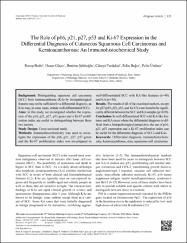The role of p16, p21, p27, p53 and Ki-67 expression in the differential diagnosis of cutaneous squamous cell carcinomas and keratoacanthomas: an immunohistochemical study

View/
Access
info:eu-repo/semantics/openAccessDate
2016Author
Bedir, RecepGüçer, Hasan
Şehitoğlu, İbrahim
Yurdakul, Cüneyt
Bağcı, Pelin
Üstüner, Pelin Doğa
Metadata
Show full item recordCitation
Bedir, R., Gucer, H., Sehitoglu, I., Yurdakul, C., Bagci, P., Ustuner, P. (2016). The role of p16, p21, p27, p53 and Ki-67 expression in the differential diagnosis of cutaneous squamous cell carcinomas and keratoacanthomas: an immunohistochemical study. Balkan Medical Journal, 33(2), 121-127. https://app.trdizin.gov.tr/makale/TWpBNE5Ea3lNZz09Abstract
Background: Distinguishing squamous cell carcinoma (SCC) from keratoacanthoma (KA) by histopathological features may not be sufficient for a differential diagnosis, as KAs may, in some cases, imitate well-differentiated SCCs. Aims: In this study, we investigated whether the expression of the p16, p21, p27, p53 genes and a Ki-67 proliferation index are useful in distinguishing between these two tumors. Study Design: Cross-sectional study. Methods: Immunohistochemistry was used to investigate the expression of the p16, p21, p27, p53 genes and the Ki-67 proliferation index was investigated in well-differentiated SCC with KA-like features (n=40) and KA (n=30). Results: The results of all of the examined markers, except for p27 (p16, p21, p53, and Ki-67) were found to be significantly different between the SCC and KA samples (p<0.05). Conclusion: In well-differentiated SCC with KA-like features and KA cases where the differential diagnosis is difficult from a histopathological perspective, the use of p16, p21, p53 expression and a Ki-67 proliferation index can be useful for the differential diagnosis of SCCs and KAs.

















